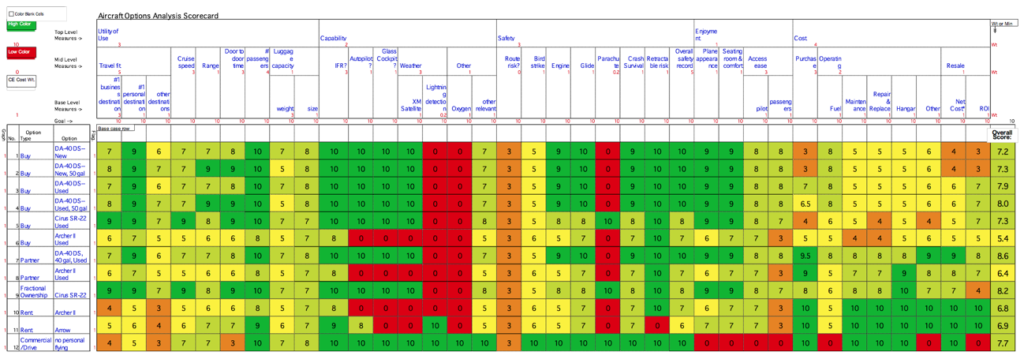Training and software for multi-criteria decision analysis, solving complex problems with uncertainty
For a difficult, important decision, it is not enough to research and think carefully. A complex problem involving tradeoffs between conflicting objectives and uncertainty requires a multi-criteria decision analysis tool and “what if?,” sensitivity analysis comparing options and possible developments.
The multi-criteria “scorecard” below was used to select the best option for a company considering an aircraft purchase. While it looks difficult and complex, the analysis is actually quite simple with the software and a few hours of training. Alternatives in rows, are rated and compared by all the criteria or factors bearing on the decision organized in columns. Appropriate weights (some factors more important than others) are applied, and a weighted average score is calculated. Uncertain as to which factors are most important?—change the weight, and see how that changes the total weighted score. Look at how the alternatives perform across a variety of scenarios. Trying to keep track of all these tradeoffs and issues in your head, or in a spreadsheet or PowerPoint presentation, is impossible. You need this software—and you need to do sensitivity analysis, inputting different ratings and possibilities to see how alternatives perform under different circumstances.
Disagree on weights or performance of some options by a criteria?—input the conflicting views and see if they matter. Most of the time they won’t. In a complex decision, major differences on some issues don’t change the overall ranking of alternatives, so there is no need to resolve the disagreement (saving time and avoiding arguments). The best part about using this software and the analysis process is that you come up with ideas to change the options under consideration, avoiding some vulnerabilities, overcoming shortcomings, and hedging against adverse developments.
With the software, it takes very little time (minutes) to build the scorecard. The time investment is in collecting data and considering risks and ways to adjust and improve the alternatives. The payoff is both development of better alternatives to choose from, and identification of a “robust” alternative that performs best under a wide range of different scenarios.
“Quick Analysis for Busy Decision Makers” training (a 3 hour course) is offered for $250/person at our training facility in Colorado Springs (includes the software, an Excel add-in program). A3 personnel can also train on site at your facility for $5,000. For more information, contact Dr. Drew Miller at drmiller@advanaapp.com or 402-952-5339.

